Abstract
Pretreatment with pertussis toxin inhibits angiotensin II-induced activation of polyphosphoinositide phosphodiesterase in rat renal mesangial cells [Pfeilschifter & Bauer (1986) Biochem. J. 236, 289-294]. Furthermore, activation of protein kinase C by the phorbol ester 12-O-tetradecanoylphorbol 13-acetate (TPA) and by 1-oleoyl-2-acetylglycerol (OAG) abolishes angiotensin II-induced formation of inositol trisphosphate (IP3) in mesangial cells [Pfeilschifter (1986) FEBS Lett. 203, 262-266]. Using membrane preparations of [3H]inositol-labelled mesangial cells we tried to obtain further insight as to the step at which protein kinase C might interfere with the signal transduction mechanism in mesangial cells. Angiotensin II (100 nM) stimulates IP3 formation from membrane preparations of [3H]inositol-labelled mesangial cells with a half-maximal potency of 1.1 nM. The angiotensin II-induced formation of IP3 is enhanced by GTP. This effect of angiotensin II is completely blocked by the competitive antagonist [Sar1,Ala8]angiotensin II. Guanosine 5'-[gamma-thio]triphosphate (GTP gamma S) and guanosine 5'-[beta gamma-imido]triphosphate (Gpp[NH]p), non-hydrolysable analogues of GTP, stimulate IP3 production in the absence of angiotensin II with Kd values of 0.19 microM and 2.4 microM, respectively. Angiotensin II augments the increase in IP3 formation induced by GTP gamma S. However, when mesangial cells were pretreated with TPA there was a dose-dependent inhibition of the synergistic action of angiotensin II on GTP gamma S-induced IP3 production. Comparable results are obtained with OAG, while the non-tumour-promoting phorbol ester 4 alpha-phorbol 12,13-didecanoate is without effect. These results suggest that activation of protein kinase C in mesangial cells does not impair phosphoinositide hydrolysis by stable GTP analogues but somehow seems to interfere with the stimulatory interaction of the occupied angiotensin II receptor with the transducing G-protein.
Full text
PDF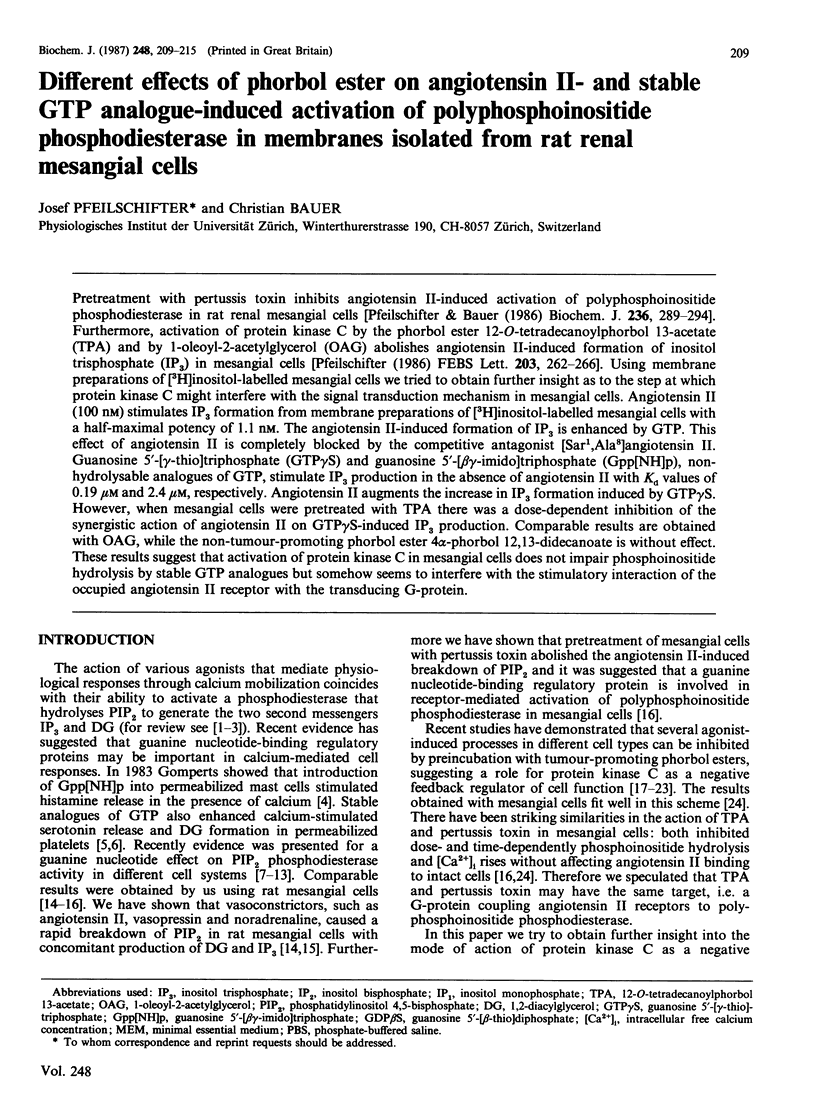
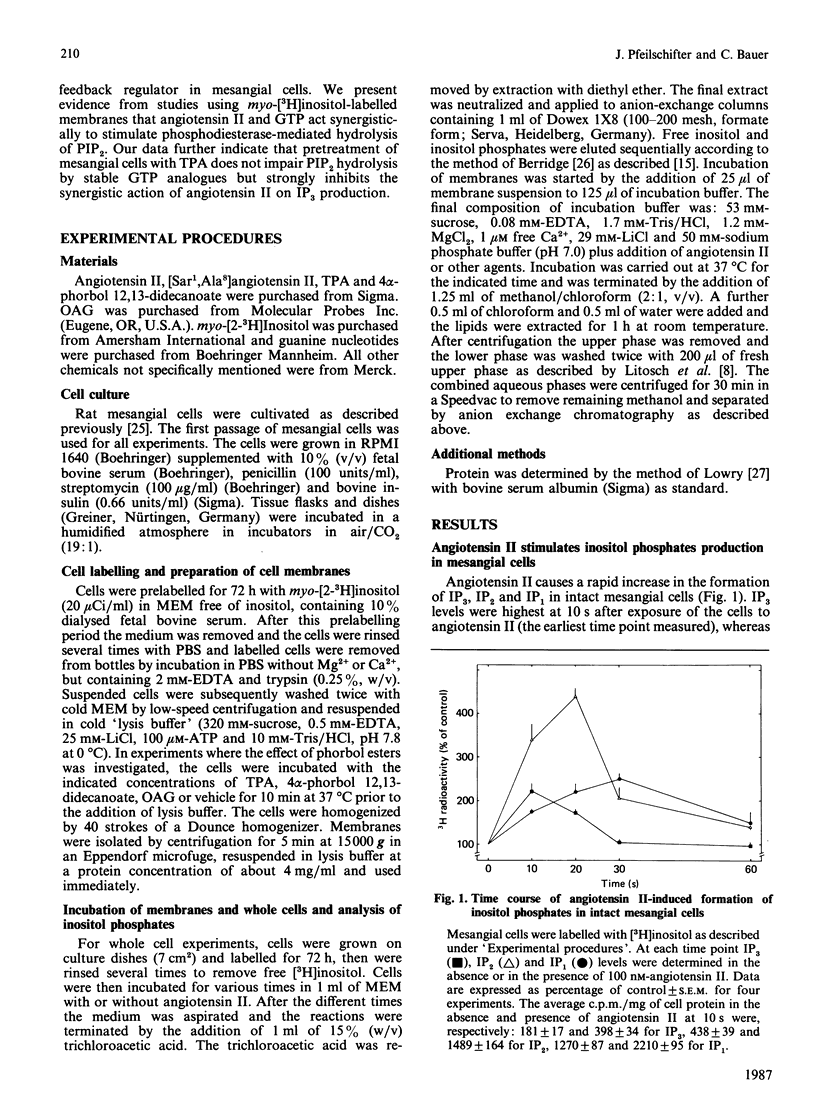
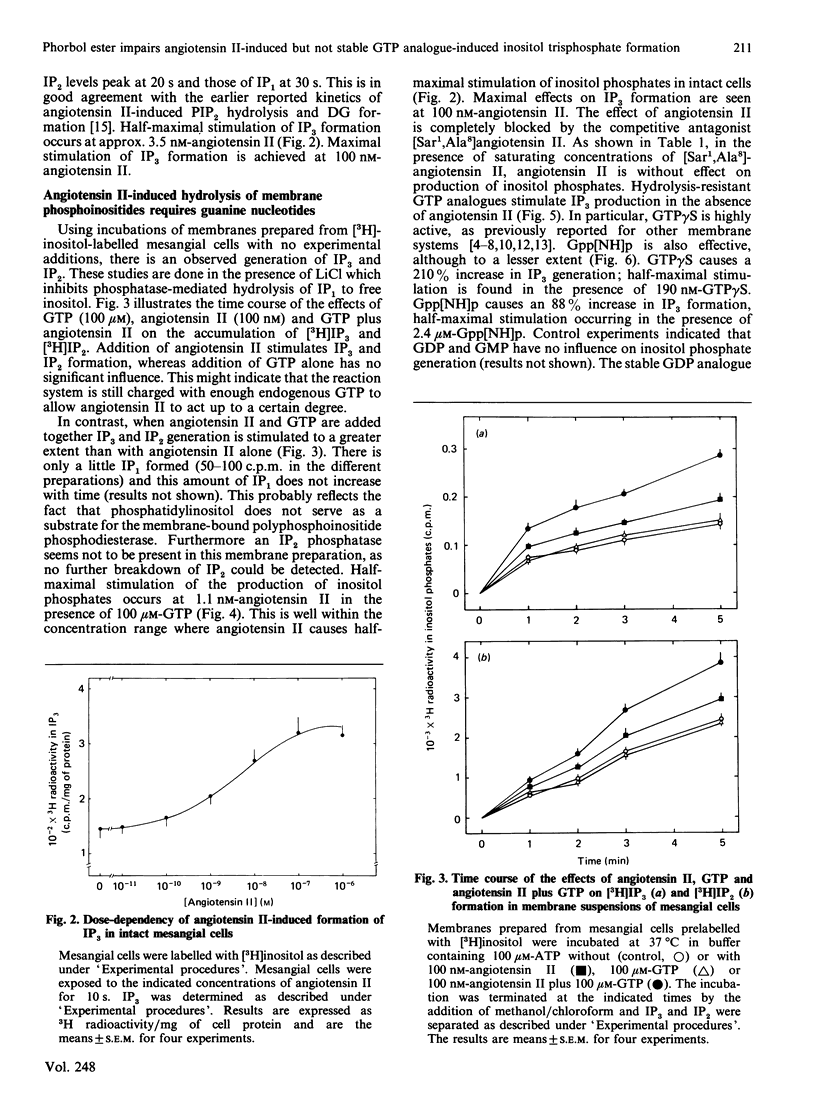
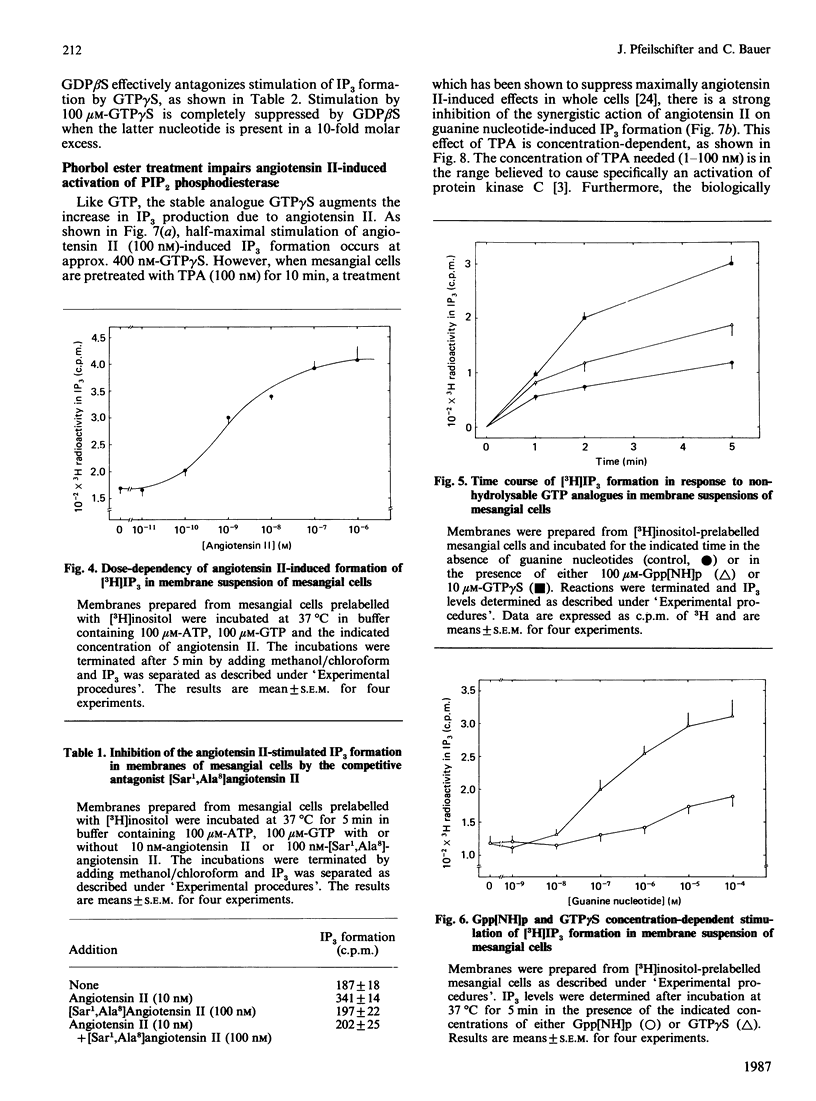
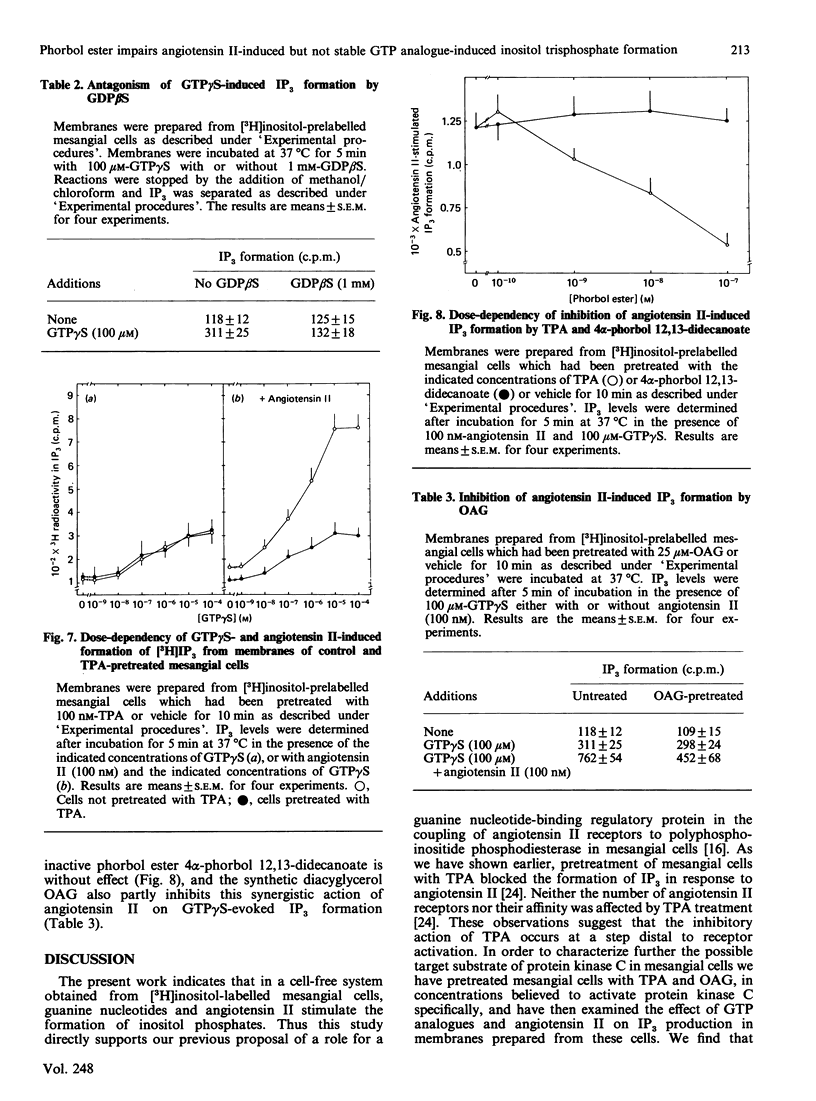
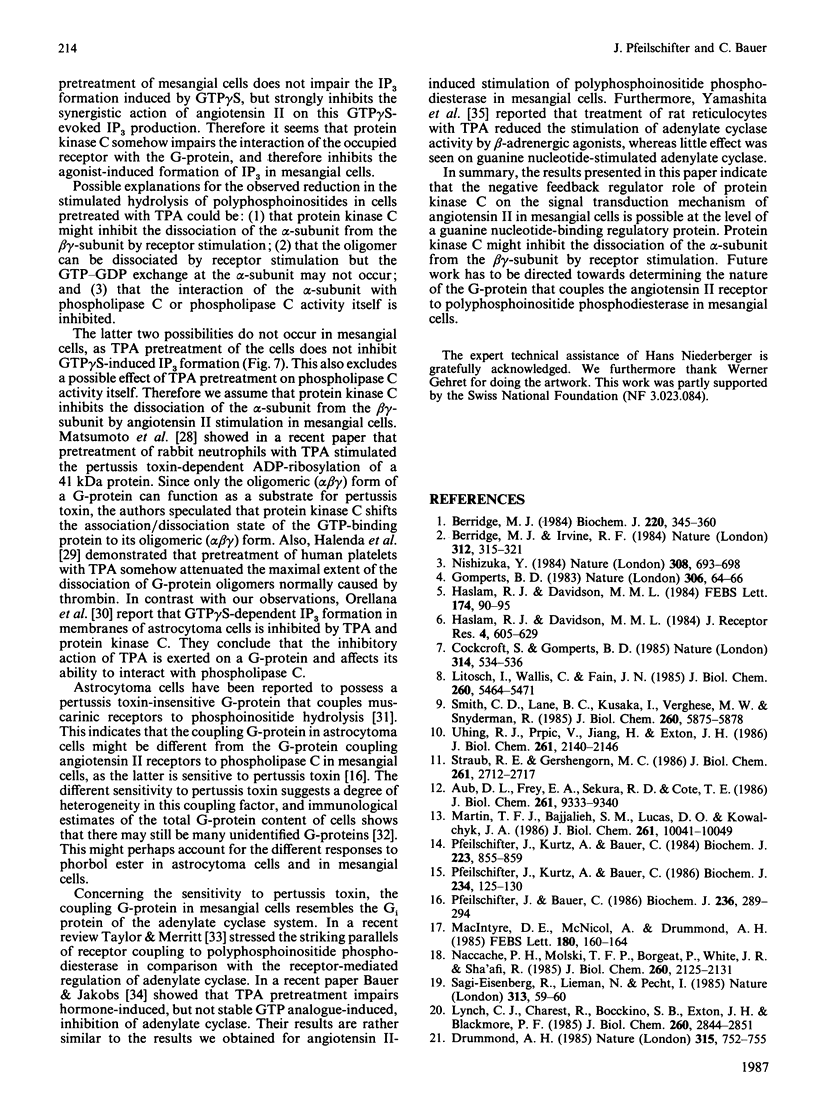
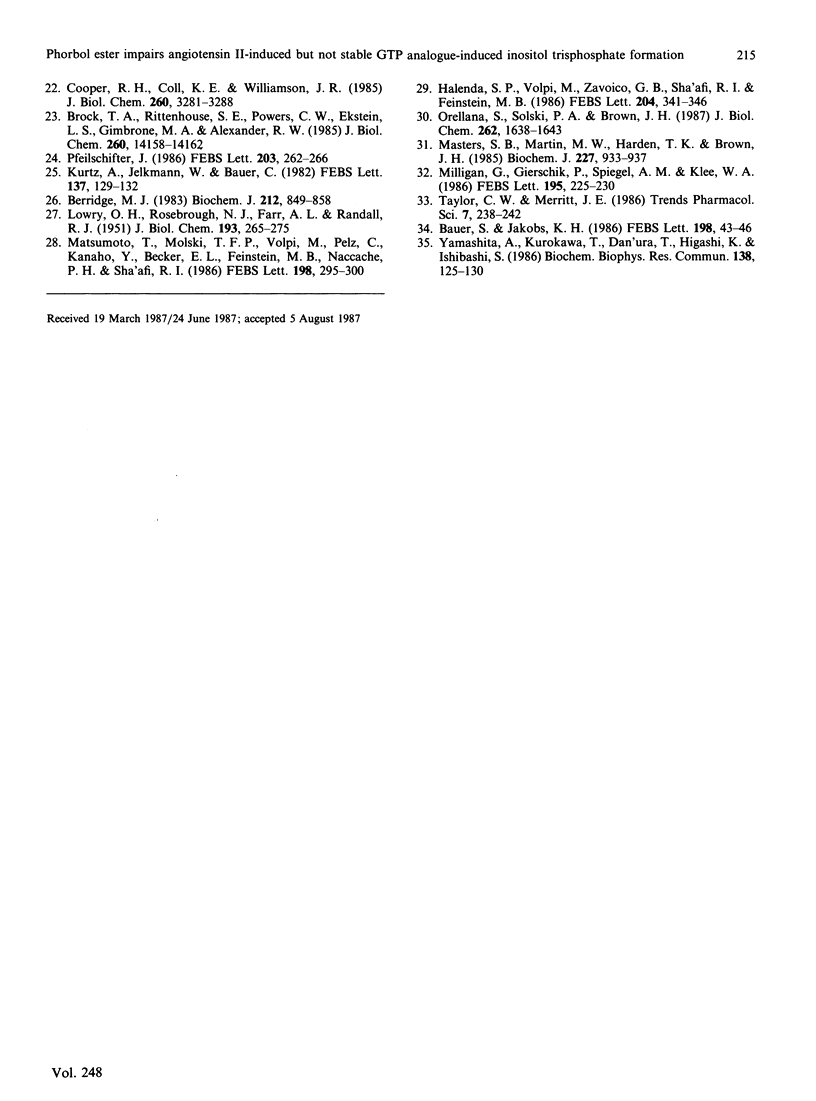
Selected References
These references are in PubMed. This may not be the complete list of references from this article.
- Aub D. L., Frey E. A., Sekura R. D., Cote T. E. Coupling of the thyrotropin-releasing hormone receptor to phospholipase C by a GTP-binding protein distinct from the inhibitory or stimulatory GTP-binding protein. J Biol Chem. 1986 Jul 15;261(20):9333–9340. [PubMed] [Google Scholar]
- Bauer S., Jakobs K. H. Phorbol ester treatment impairs hormone- but not stable GTP analog-induced inhibition of adenylate cyclase. FEBS Lett. 1986 Mar 17;198(1):43–46. doi: 10.1016/0014-5793(86)81181-4. [DOI] [PubMed] [Google Scholar]
- Berridge M. J. Inositol trisphosphate and diacylglycerol as second messengers. Biochem J. 1984 Jun 1;220(2):345–360. doi: 10.1042/bj2200345. [DOI] [PMC free article] [PubMed] [Google Scholar]
- Berridge M. J. Rapid accumulation of inositol trisphosphate reveals that agonists hydrolyse polyphosphoinositides instead of phosphatidylinositol. Biochem J. 1983 Jun 15;212(3):849–858. doi: 10.1042/bj2120849. [DOI] [PMC free article] [PubMed] [Google Scholar]
- Brock T. A., Rittenhouse S. E., Powers C. W., Ekstein L. S., Gimbrone M. A., Jr, Alexander R. W. Phorbol ester and 1-oleoyl-2-acetylglycerol inhibit angiotensin activation of phospholipase C in cultured vascular smooth muscle cells. J Biol Chem. 1985 Nov 15;260(26):14158–14162. [PubMed] [Google Scholar]
- Cockcroft S., Gomperts B. D. Role of guanine nucleotide binding protein in the activation of polyphosphoinositide phosphodiesterase. Nature. 1985 Apr 11;314(6011):534–536. doi: 10.1038/314534a0. [DOI] [PubMed] [Google Scholar]
- Cooper R. H., Coll K. E., Williamson J. R. Differential effects of phorbol ester on phenylephrine and vasopressin-induced Ca2+ mobilization in isolated hepatocytes. J Biol Chem. 1985 Mar 25;260(6):3281–3288. [PubMed] [Google Scholar]
- Drummond A. H. Bidirectional control of cytosolic free calcium by thyrotropin-releasing hormone in pituitary cells. 1985 Jun 27-Jul 3Nature. 315(6022):752–755. doi: 10.1038/315752a0. [DOI] [PubMed] [Google Scholar]
- Gomperts B. D. Involvement of guanine nucleotide-binding protein in the gating of Ca2+ by receptors. Nature. 1983 Nov 3;306(5938):64–66. doi: 10.1038/306064a0. [DOI] [PubMed] [Google Scholar]
- Halenda S. P., Volpi M., Zavoico G. B., Sha'afi R. I., Feinstein M. B. Effects of thrombin, phorbol myristate acetate and prostaglandin D2 on 40-41 kDa protein that is ADP ribosylated by pertussis toxin in platelets. FEBS Lett. 1986 Aug 18;204(2):341–346. doi: 10.1016/0014-5793(86)80840-7. [DOI] [PubMed] [Google Scholar]
- Haslam R. J., Davidson M. M. Guanine nucleotides decrease the free [Ca2+] required for secretion of serotonin from permeabilized blood platelets. Evidence of a role for a GTP-binding protein in platelet activation. FEBS Lett. 1984 Aug 20;174(1):90–95. doi: 10.1016/0014-5793(84)81084-4. [DOI] [PubMed] [Google Scholar]
- Haslam R. J., Davidson M. M. Receptor-induced diacylglycerol formation in permeabilized platelets; possible role for a GTP-binding protein. J Recept Res. 1984;4(1-6):605–629. doi: 10.3109/10799898409042576. [DOI] [PubMed] [Google Scholar]
- Kurtz A., Jelkmann W., Bauer C. Mesangial cells derived from rat glomeruli produce an erythropoiesis stimulating factor in cell culture. FEBS Lett. 1982 Jan 11;137(1):129–132. doi: 10.1016/0014-5793(82)80330-x. [DOI] [PubMed] [Google Scholar]
- LOWRY O. H., ROSEBROUGH N. J., FARR A. L., RANDALL R. J. Protein measurement with the Folin phenol reagent. J Biol Chem. 1951 Nov;193(1):265–275. [PubMed] [Google Scholar]
- Litosch I., Wallis C., Fain J. N. 5-Hydroxytryptamine stimulates inositol phosphate production in a cell-free system from blowfly salivary glands. Evidence for a role of GTP in coupling receptor activation to phosphoinositide breakdown. J Biol Chem. 1985 May 10;260(9):5464–5471. [PubMed] [Google Scholar]
- Lynch C. J., Charest R., Bocckino S. B., Exton J. H., Blackmore P. F. Inhibition of hepatic alpha 1-adrenergic effects and binding by phorbol myristate acetate. J Biol Chem. 1985 Mar 10;260(5):2844–2851. [PubMed] [Google Scholar]
- MacIntyre D. E., McNicol A., Drummond A. H. Tumour-promoting phorbol esters inhibit agonist-induced phosphatidate formation and Ca2+ flux in human platelets. FEBS Lett. 1985 Jan 28;180(2):160–164. doi: 10.1016/0014-5793(85)81063-2. [DOI] [PubMed] [Google Scholar]
- Masters S. B., Martin M. W., Harden T. K., Brown J. H. Pertussis toxin does not inhibit muscarinic-receptor-mediated phosphoinositide hydrolysis or calcium mobilization. Biochem J. 1985 May 1;227(3):933–937. doi: 10.1042/bj2270933. [DOI] [PMC free article] [PubMed] [Google Scholar]
- Matsumoto T., Molski T. F., Volpi M., Pelz C., Kanaho Y., Becker E. L., Feinstein M. B., Naccache P. H., Sha'afi R. I. Treatment of rabbit neutrophils with phorbol esters results in increased ADP-ribosylation catalyzed by pertussis toxin and inhibition of the GTPase stimulated by fMet-Leu-Phe. FEBS Lett. 1986 Mar 31;198(2):295–300. doi: 10.1016/0014-5793(86)80424-0. [DOI] [PubMed] [Google Scholar]
- Milligan G., Gierschik P., Spiegel A. M., Klee W. A. The GTP-binding regulatory proteins of neuroblastoma x glioma, NG108-15, and glioma, C6, cells. Immunochemical evidence of a pertussis toxin substrate that is neither Ni nor No. FEBS Lett. 1986 Jan 20;195(1-2):225–230. doi: 10.1016/0014-5793(86)80165-x. [DOI] [PubMed] [Google Scholar]
- Naccache P. H., Molski T. F., Borgeat P., White J. R., Sha'afi R. I. Phorbol esters inhibit the fMet-Leu-Phe- and leukotriene B4-stimulated calcium mobilization and enzyme secretion in rabbit neutrophils. J Biol Chem. 1985 Feb 25;260(4):2125–2131. [PubMed] [Google Scholar]
- Nishizuka Y. The role of protein kinase C in cell surface signal transduction and tumour promotion. Nature. 1984 Apr 19;308(5961):693–698. doi: 10.1038/308693a0. [DOI] [PubMed] [Google Scholar]
- Orellana S., Solski P. A., Brown J. H. Guanosine 5'-O-(thiotriphosphate)-dependent inositol trisphosphate formation in membranes is inhibited by phorbol ester and protein kinase C. J Biol Chem. 1987 Feb 5;262(4):1638–1643. [PubMed] [Google Scholar]
- Pfeilschifter J., Bauer C. Pertussis toxin abolishes angiotensin II-induced phosphoinositide hydrolysis and prostaglandin synthesis in rat renal mesangial cells. Biochem J. 1986 May 15;236(1):289–294. doi: 10.1042/bj2360289. [DOI] [PMC free article] [PubMed] [Google Scholar]
- Pfeilschifter J., Kurtz A., Bauer C. Activation of phospholipase C and prostaglandin synthesis by [arginine]vasopressin in cultures. Biochem J. 1984 Nov 1;223(3):855–859. doi: 10.1042/bj2230855. [DOI] [PMC free article] [PubMed] [Google Scholar]
- Pfeilschifter J., Kurtz A., Bauer C. Role of phospholipase C and protein kinase C in vasoconstrictor-induced prostaglandin synthesis in cultured rat renal mesangial cells. Biochem J. 1986 Feb 15;234(1):125–130. doi: 10.1042/bj2340125. [DOI] [PMC free article] [PubMed] [Google Scholar]
- Pfeilschifter J. Tumour promotor 12-O-tetradecanoylphorbol 13-acetate inhibits angiotensin II-induced inositol phosphate production and cytosolic Ca2+ rise in rat renal mesangial cells. FEBS Lett. 1986 Jul 28;203(2):262–266. doi: 10.1016/0014-5793(86)80755-4. [DOI] [PubMed] [Google Scholar]
- Sagi-Eisenberg R., Lieman H., Pecht I. Protein kinase C regulation of the receptor-coupled calcium signal in histamine-secreting rat basophilic leukaemia cells. Nature. 1985 Jan 3;313(5997):59–60. doi: 10.1038/313059a0. [DOI] [PubMed] [Google Scholar]
- Smith C. D., Lane B. C., Kusaka I., Verghese M. W., Snyderman R. Chemoattractant receptor-induced hydrolysis of phosphatidylinositol 4,5-bisphosphate in human polymorphonuclear leukocyte membranes. Requirement for a guanine nucleotide regulatory protein. J Biol Chem. 1985 May 25;260(10):5875–5878. [PubMed] [Google Scholar]
- Straub R. E., Gershengorn M. C. Thyrotropin-releasing hormone and GTP activate inositol trisphosphate formation in membranes isolated from rat pituitary cells. J Biol Chem. 1986 Feb 25;261(6):2712–2717. [PubMed] [Google Scholar]
- Uhing R. J., Prpic V., Jiang H., Exton J. H. Hormone-stimulated polyphosphoinositide breakdown in rat liver plasma membranes. Roles of guanine nucleotides and calcium. J Biol Chem. 1986 Feb 15;261(5):2140–2146. [PubMed] [Google Scholar]
- Yamashita A., Kurokawa T., Dan'ura T., Higashi K., Ishibashi S. Induction of desensitization by phorbol ester to beta-adrenergic agonist stimulation in adenylate cyclase system of rat reticulocytes. Biochem Biophys Res Commun. 1986 Jul 16;138(1):125–130. doi: 10.1016/0006-291x(86)90255-x. [DOI] [PubMed] [Google Scholar]


